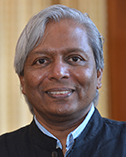
K. VijayRaghavan
National Centre for Biological Sciences
|
Primary Section: 22, Cellular and Developmental Biology Secondary Section: 24, Cellular and Molecular Neuroscience Membership Type:
International Member
(elected 2014)
|
Biosketch
Krishnaswamy (Vijay) VijayRaghavan is the Secretary, Department of Biotechnology, Government of India since January 28, 2013, prior to which he was the Director of the National Centre for Biological Sciences (NCBS) of the Tata Institute of Fundamental Research (TIFR) and the interim head of The Institute of Stem Cell Biology and Regenerative Medicine (inStem) a new autonomous institute of the Department of Biotechnology. He was conferred an honorary Doctor of Science degree by the University of Edinburgh in 2011. He is a J. C. Bose Fellow of the Department of Science and Technology. He gave the J.C. Bose Memorial Lecture at the Royal Society in 2010. He was awarded the inaugural Infosys Prize in Life Sciences 2009, The Shanti Swarup Bhatnagar Prize in 1998 and is a Distinguished Alumnus of the Indian Institute of Technology, Kanpur, the Institute’s highest honour. He is a fellow of The Indian Science Academies, an Associate Member of the European Molecular Biology Organization and a Fellow of the Royal Society. He was awarded the ‘Padma-Shri’ in 2013, by the Government of India. VijayRaghavan is on the Board of Governors of the Okinawa Institute of Science and Technology, on the Scientific Advisory Board of IFOM, Milan and of the Janelia Farm Research Campus of the Howard Hughes Medical Institute. VijayRaghavan is a Senior Editor of eLife.
Research Interests
VijayRaghavan’s laboratory studies the neuronal circuits in the brain and motor system the development of muscles. His group uses molecular markers to chart the development of muscles in the fruitfly Drosophila. The laboratory dissected the specification of segment-identity through the action of Hox genes in the epidermis, the nervous system and in the muscles themselves, each in distinct steps of development. These and other studies have provided a comprehensive picture of the mechanisms of flight muscle development. Most recently, they have identified a stem-cell population that makes flight muscles. The laboratory has contributed to the understanding of how stem cell lineages contribute to the development of the olfactory circuits in the antennal lobe of the fly and also of the walking motor-circuit. The laboratory’s work on muscles and the motor system have now allowed the study of how the ability for coordinated locomotion emerges during development.

